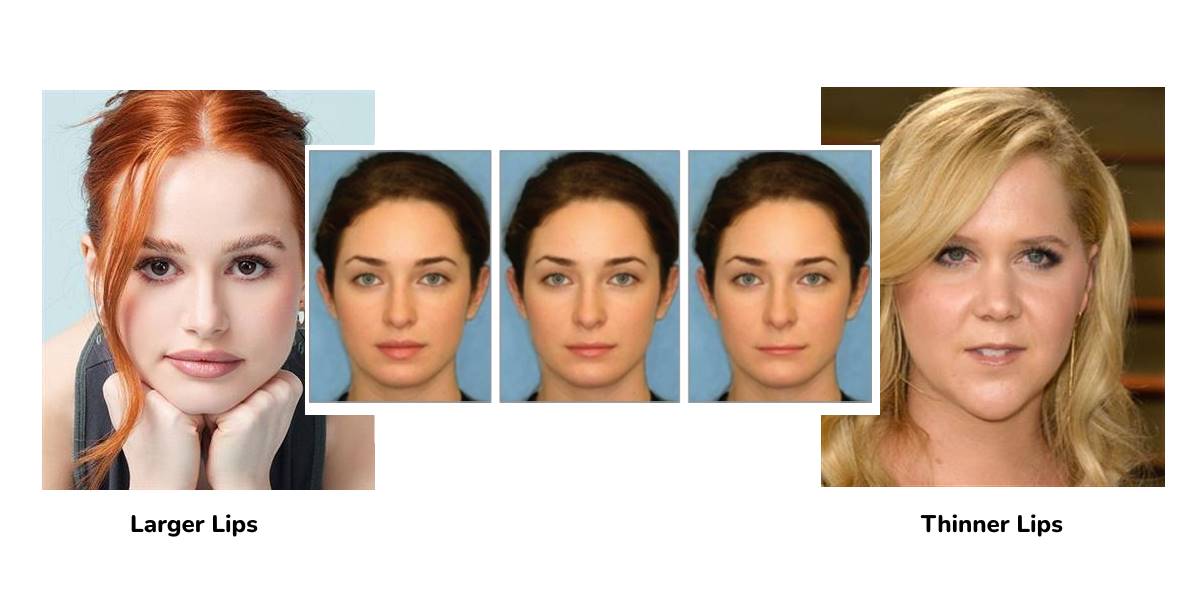Summary
Several studies highlight the attractiveness of fuller and larger lips in females. Sawyer et al. (2009) found the mean lower lip height in females to be 12.6 mm, with a range of 8.1 mm to 18.3 mm. Kar et al. (2018) emphasize that fuller lips relative to facial width and greater vermilion height are considered attractive, as they contribute to facial harmony and balance. Modarai et al. (2013) support this, noting that a prominent lower lip enhances facial attractiveness by influencing chin prominence perception. Pallett et al. (2010) assert that large lips, indicative of strong mating potential, are always more attractive than narrow lips. Trookman et al. (2009) associate larger lips with vitality and youth, while thinner lips suggest aging and fragility. Fink & Neave (2005) link full lips to reproductive health. Popenko et al. (2017) identify the most appealing lip dimensions with an ideal upper lip to lower lip ratio of 1:2, while Kar et al. (2018) suggest a 1:1.6 ratio for balance. Anic-Milosevic et al. (2010) found that females have a proportionately larger lower lip height than males. These findings collectively indicate that a larger lower lip is more aesthetically pleasing for females.
Research
A research study by Sawyer et al. (2009) mentions the mean lower lip for female is 12.6 mm. Moreover, the study also highlights the range which is 8.1 mm to 18.3 mm.
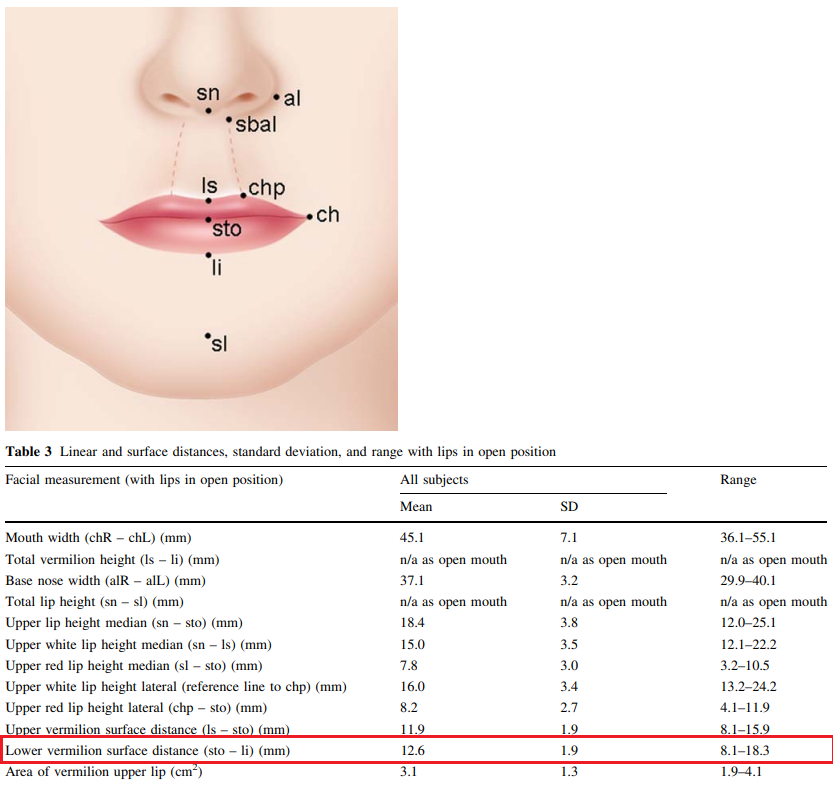
According to a medical publication produced by Kar, and colleagues (2018), “in females, fuller lips in relation to facial width as well as greater vermilion height are considered to be attractive”. In other words, they explain that larger and fuller lips are considered beautiful.
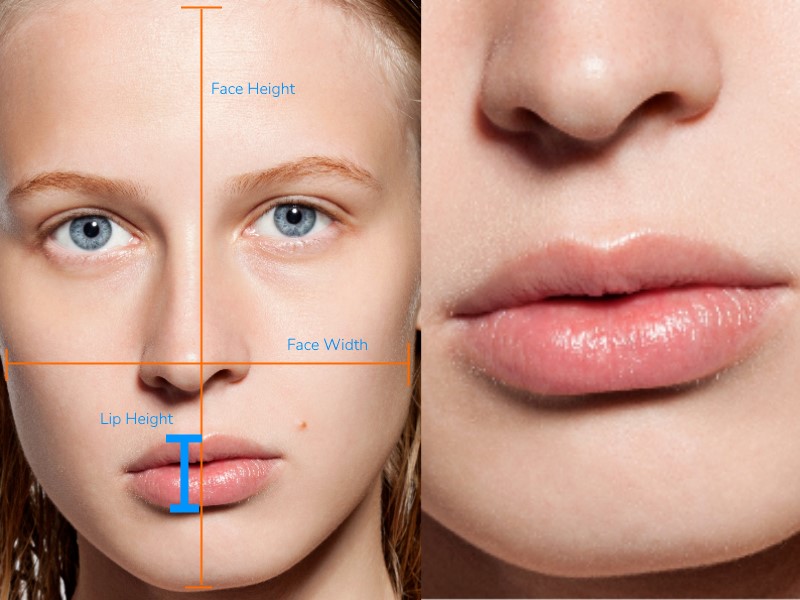
They go on to explain that, “Beauty is defined as a state of harmony – a balance of facial proportions – a balanced relationship among skeletal structures, teeth, and soft tissue” and “the lips are an essential component of the symmetry and aesthetics of the face”.
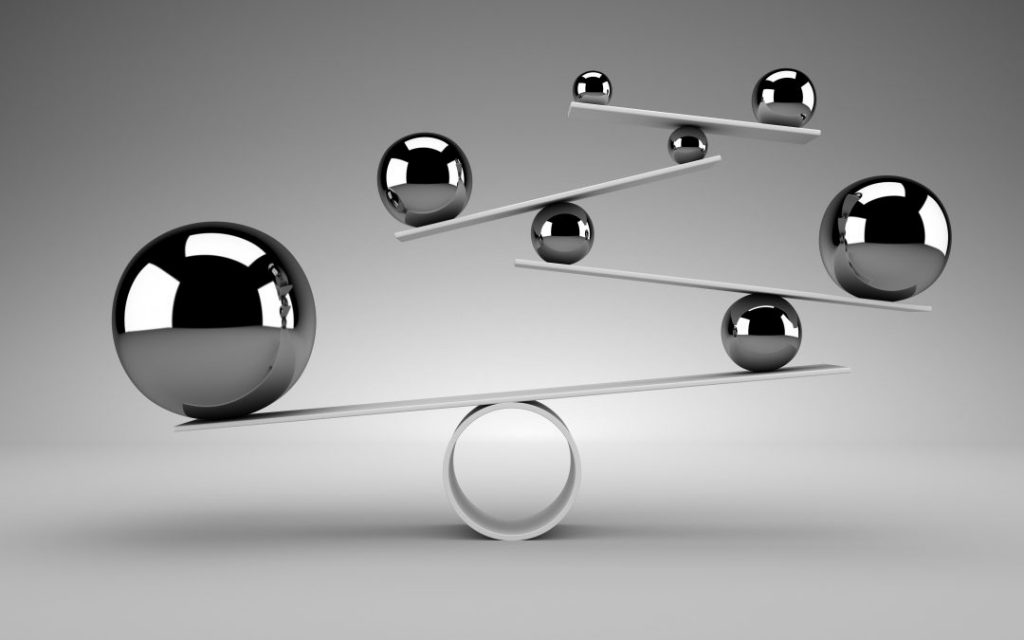
This finding is further supported by another study conducted by Modarai (et al, 2013). These medical practitioners explained that a more prominent lower lip and its protrusive position relative to a chin’s prominence provide a noteworthy impact on facial attractiveness. They explain that “The lower lip is the adjacent aesthetic subunit to the chin. As such, the prominence of the lower lip may influence the perception of chin prominence”
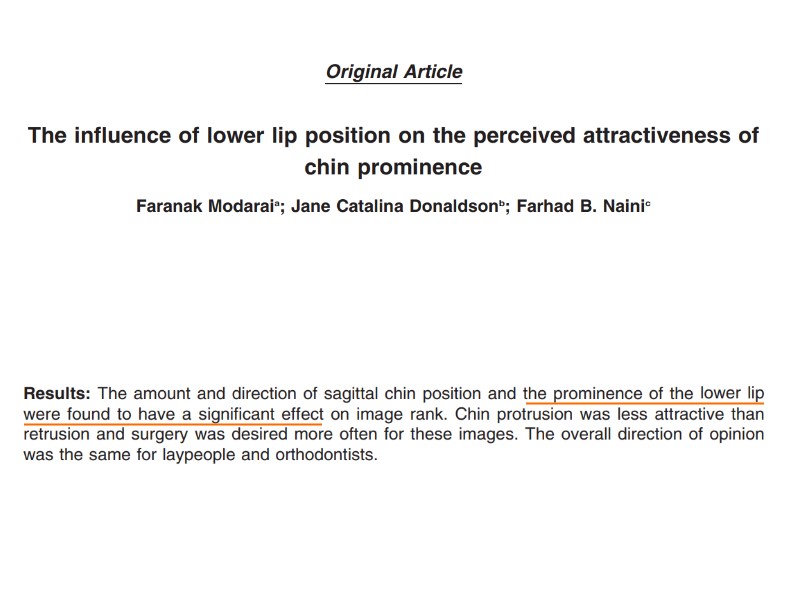
Pallett et al, (2010) state concretely that “A woman who has large lips, suggesting a strong mating potential, with average length and width ratios will always be more attractive than a woman with narrow lips and average length and width ratios”
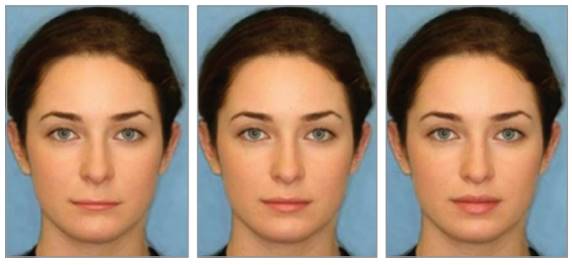
Larger lips show vitality and youth, while flat, thin lips are suggestive of fragility and ageing (Trookman et al, 2009). These authors also showed with histological analysis that during ageing, a reduction in the synthesis of collagen and thinning of tissue layers can make the lips appear deflated. They summarise that “The appearance of the lips has a major effect on aesthetic impressions of an individual and on the overall attractiveness of the face”.
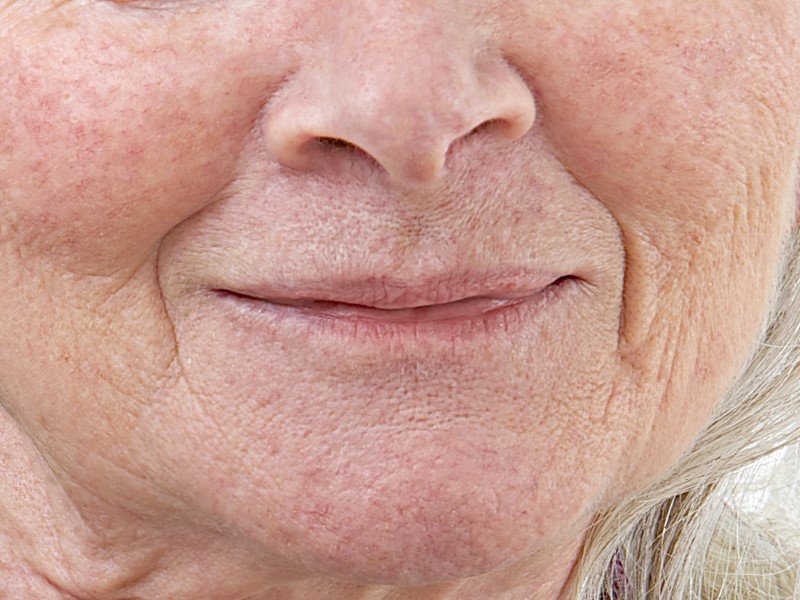
Full lips have long been desired by women because they signify youth and femininity. This sexually dimorphic feature serves as an indication of reproductive health (Fink & Neave, 2005).
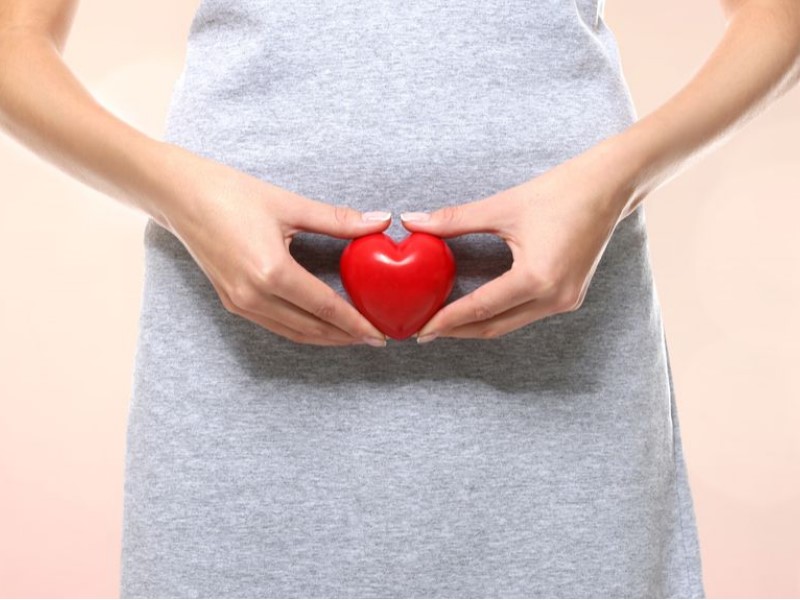
According to research by Popenko et al, (2017) the most appealing lip dimensions (of women) had a surface area that was about 53.5 % bigger than the women’s natural size, took up about 9.6 % of the lower third of their face and had a ‘potentially ideal’ upper lip to lower lip ratio of 1:2.
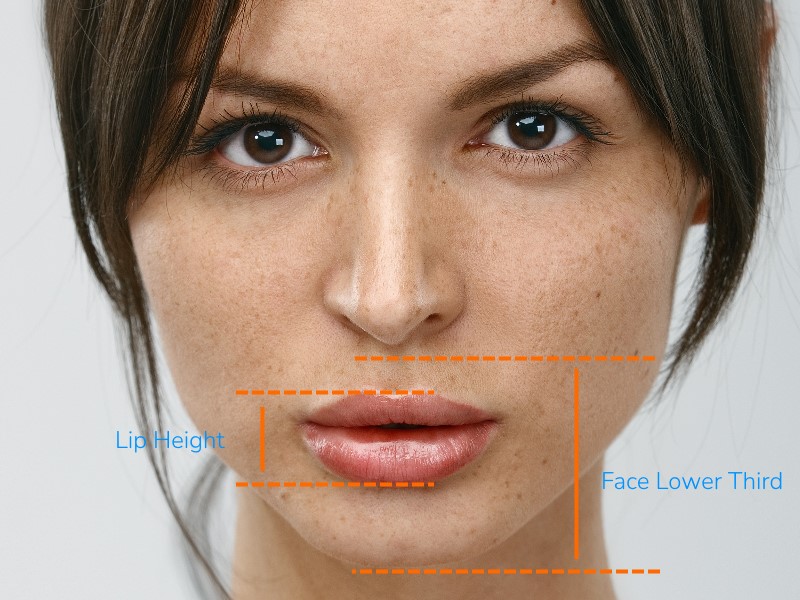
They also close their findings with a note that “conversely, the ratio of 2:1 was deemed least attractive” meaning that during aesthetic assessment, women with a thicker upper lip width and thinner lower lip are actually voted to be the least attractive out of every lip combination.
Similarly, another research study by Kar et al. (2018) suggested that the ideal upper lip to lower lip ratio is 1:1.6, meaning the upper lip’s vertical height should be less than that of the lower lip. It is important for the balance and harmony of facial features. Many females might seek augmentation of the upper lip without considering this balance, which can result in unnatural appearances like “sausage” or “duck” lips. Therefore, a larger lower lip is better for females because it aligns with the ideal aesthetic proportions.
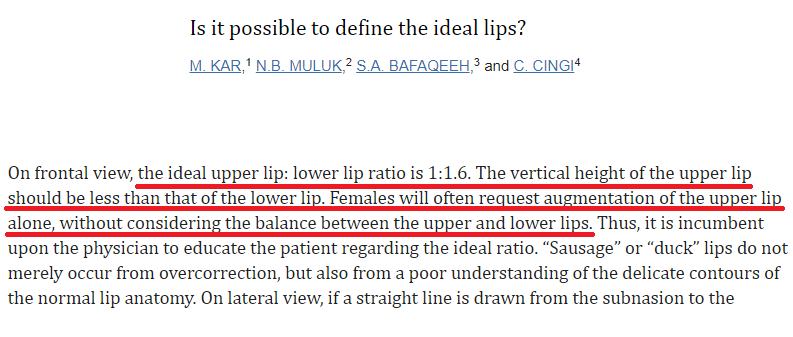
A research by Anic-Milosevic et al. (2010) indicates that the lower lip height in females is proportionately larger compared to males. Specifically, in females, the lower lip height reaches 70.75% of the entire chin height, which is significantly greater than the 66.54% observed in males. This suggests that a fuller lower lip is more characteristic of females.
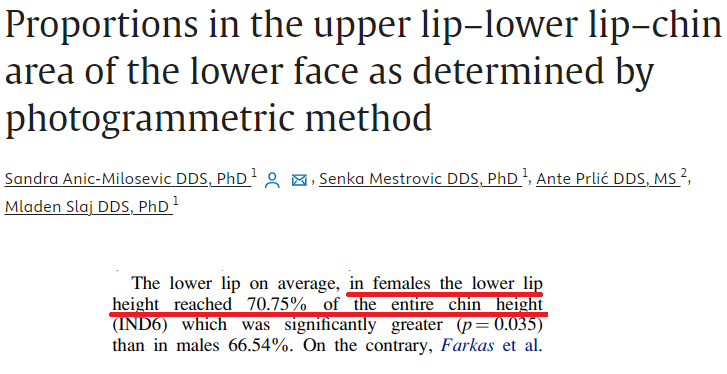
These scientific evidences strongly suggest that a larger lower lip height is more aesthetically pleasing than a smaller one.
References
Sawyer, A. R., See, M., & Nduka, C. (2009). 3D stereophotogrammetry quantitative lip analysis. Aesthetic plastic surgery, 33, 497-504. https://doi.org/10.1007/s00266-008-9191-1
Kar, M., Muluk, N. B., Bafaqeeh, S. A., Cingi, C., 2018. Is it possible to define the ideal lips?. ACTA otorhinolaryngologica Italica. https://doi.org/10.14639/0392-100X-1511
Modarai, F., Donaldson, J. C., Naini, F. B., 2013. The influence of lower lip position on the perceived attractiveness of chin prominence. The Angle orthodontist. 83, 5. 795 – 800. https://doi.org/10.2319/122912-974.1
Pallett, P. M., Link, S., Lee, K., 2010. New golden ratios for facial beauty. Vision Research, 50, 2. 149 – 154. https://doi.org/10.1016/j.visres.2009.11.003
Trookman, N. S., Rizer, R. L., Ford, R., Rahul Mehta, R., Gotz, V., 2009. Clinical Assessment of a Combination Lip Treatment to Restore Moisturization and Fullness. Journal of Clinical and Aesthetic Dermatology. 2, 12. 44 – 48. https://www.ncbi.nlm.nih.gov/pmc/articles/PMC2923945/.
Fink, B., & Neave, N. (2005). The biology of facial beauty. International Journal of Cosmetic Science. 27, 6. 317 – 325. https://doi.org/10.1111/j.1467-2494.2005.00286.x
Popenko, N. A., Tripathi, P. B., Devcic, Z., Karimi, K., Osann, K., Wong, B., 2017. A Quantitative Approach to Determining the Ideal Female Lip Aesthetic and Its Effect on Facial Attractiveness. JAMA Facial Plastic Surgery. 19, 4. 261 – 267. https://doi.org/10.1001/jamafacial.2016.2049
Anic-Milosevic, S., Mestrovic, S., Prlić, A., & Slaj, M. (2010). Proportions in the upper lip–lower lip–chin area of the lower face as determined by photogrammetric method. Journal of Cranio-Maxillofacial Surgery, 38(2), 90-95. https://doi.org/10.1016/j.jcms.2009.03.013
